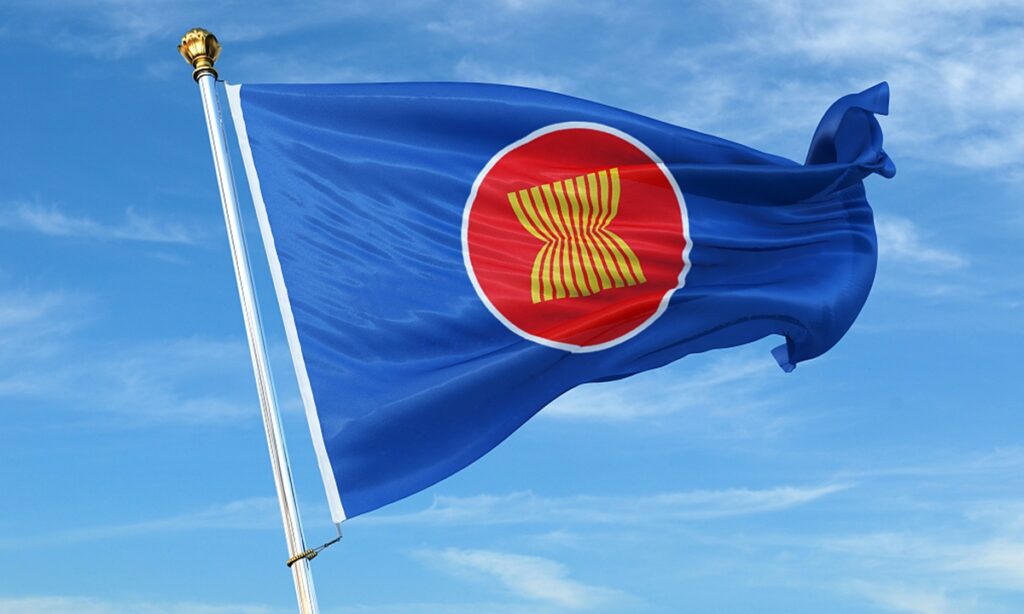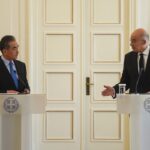While member states of ASEAN were discussing economic recovery and key topics related to regional interests with China and regional countries during the East Asia Summit via video link on Wednesday, the US and some of its allies were still trying to sow discord between China and the bloc by expressing worries over China.
The East Asia Summit is a premier leaders-led forum. Aside from ASEAN member states, the leaders of India, China, Japan, South Korea, Australia, New Zealand, the US and Russia attended the Wednesday summit.
Chinese Premier Li Keqiang attended the East Asia Summit via video link on Wednesday.
Economic cooperation and post-pandemic recovery were top of the Wednesday summit’s agenda.
Analysts noted that to grasp the opportunity to boost economic recovery, ASEAN would pay more attention to promoting regional economic integration and promoting the ASEAN Outlook on the Indo-Pacific (AOIP) to cooperate with other countries or regional initiatives for further connectivity. And they pointed out that the US Indo-Pacific Strategy, which is different from the AOIP in both purpose and content, would not swindle ASEAN members into the US’ anti-China cliques.
Meanwhile, US President Joe Biden, who also attended the Wednesday meeting, reaffirmed the US commitment to the Indo-Pacific and outlined his vision for the region, which “seeks a region that is open, connected, prosperous, resilient, and secure.” He also expressed “concerns” about the international rules-based order, according to a White House release.
This is not the first time the US and its allies have hyped South China Sea issues during ASEAN summits to sow discord between China and ASEAN, analysts said. They noted that it will never succeed due to China’s and ASEAN’s close communication and joint efforts to solve the maritime disputes via talks.
“Malaysia’s position on the South China Sea remains consistent. Issues concerning the South China Sea must be managed in a peaceful and rational manner through dialogue and consultations, utilizing appropriate fora and diplomatic channels,” Malaysia’s Prime Minister Datuk Seri Ismail Sabri Yaakob said at the Wednesday summit, the Star reported.
Biden also took part in a virtual summit with ASEAN on Tuesday, the first time in four years after Biden’s predecessor Donald Trump attended an ASEAN-US meeting in Manila of the Philippines in 2017.
Biden announced more than $100 million for an initiative to beef up the US relationship with ASEAN, according to a release on the White House website on Tuesday.
By offering economic assistance and stressing cooperation with the AOIP, Biden wants to dispel ASEAN members’ vigilance and dissatisfaction over the US-led competition with China that comes with military threats. However, the ASEAN outlook is so different from the US’ Indo-Pacific Strategy that countries in the region would not be easily fooled, analysts said.
Different strategies
At the 34th ASEAN Summit held in Bangkok, capital of Thailand on 23 June 2019, the ASEAN announced its vision of the Indo-Pacific strategies in the form of a non-binding AOIP.
The AOIP focuses on regional economic development, governance and connectivity and does not exclude other strategies or initiatives, including the China-proposed Belt and Road Initiative. Its purpose is to give ASEAN a main role in coordinating regional affairs, especially via different levels of the communication mechanisms within ASEAN, Chen Xiangmiao, an assistant research fellow at the National Institute for South China Sea Studies, told the Global Times on Wednesday.
The AOIP underscores inclusiveness, cooperation and balance. However, the US’ Indo-Pacific Strategy highlights security and military issues and its main target is to form an alliance to contain China, Chen said, noting that the US-led anti-China clique and its rivalry with China have raised concerns within ASEAN as the bloc does not want to take sides between China and the US.
The new AUKUS tripartite defense treaty inked by the US, UK and Australia was formed with the drive of intimidating China. It has seen objections from some ASEAN members, including Malaysia and Indonesia, citing concerns over nuclear proliferation and an arms race in the region.
In an ASEAN-Australia Summit held on Wednesday, Indonesian President Joko Widodo told Australian leader Scott Morrison that Jakarta is worried about AUKUS and the development of Australian nuclear submarines, which could trigger increased rivalry in the region, according to Widodo’s press office.
The core of the AOIP is not to make the region into a small circle, nor bring confrontations among great powers, or force ASEAN members to take sides. Instead, it shows that ASEAN is willing to promote cooperation with China and other countries and opposes the US’ strategy targeting China, Qian Feng, director of the research department at the National Strategy Institute at Tsinghua University, told the Global Times on Wednesday.
Experts noted that the AOIP is put forward by ASEAN out of their own needs and thinking over the global trend. It includes expectations for deepening cooperation with China and there may be connections between the AOIP with China’s development strategies.
Indian Prime Minister Narendra Modi also attended the 16th East Asia Summit on Wednesday and is scheduled to attend the 18th ASEAN-India Summit on Thursday.
The Modi administration is putting the Look East policy into action and has conducted comprehensive connections with ASEAN and its member states in the spheres of politics, economy, diplomacy and security. This echoes ASEAN’s needs for comprehensive diplomacy, said Qian.
The current frozen relations with China due to border disputes and changes in regional and international situations are pushing India to be engaged in the ASEAN summit to expand diplomatic leeway and bargaining chips, the expert noted.
But ASEAN members are discontent with India’s joining in the Quad – a small clique consisting of the US, India, Australia and Japan to exclude other regional countries, and they are worried over pressure to take sides in the competition between great powers, Qian said.
Promoting regional cooperation
Faced with the US’ increasing action in the Indo-Pacific region, China has carried out its policies focusing on regional cooperation, stressing management of disputes and promoting economic relations since these are the shared purposes of ASEAN members amid a possible global economic recession and the urgent need for economic recovery from the COVID-19 pandemic, analysts said.
Chen said that China should further promote the implementation of the Regional Comprehensive Economic Partnership (RCEP) agreement and join the Comprehensive and Progressive Trans-Pacific Partnership (CPTPP) trade agreement.
“China’s better management of disputes over security issues would help it play a bigger role in trade agreements on regional economic development,” Chen noted.
While attending the 24th ASEAN Plus China, Japan and ROK Summit on Wednesday, Premier Li has said that the RCEP will reach a threshold of entry into force soon, and countries need to hasten work for it to take effect as early as possible.
China also agreed to support the ASEAN Comprehensive Recovery Framework and its Implementation Plan, which will guide both sides in deepening their cooperation in various fields, including public health, social security, economic integration, digital transformation, and sustainable development, according to a joint statement issued following conclusion of the 24th ASEAN-China Summit held online on Tuesday.



